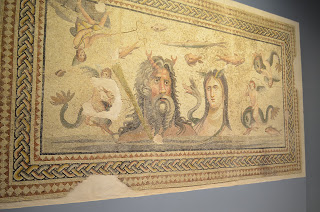Harran has lots of ruins and is a dusty dusty town. It is known for its "beehives" homes (designs from BC but current ones seen are about 300 years old) that betray the city's age. Though these homes are no longer inhabited, they have well preserved and spread across the town. Upon our arrival, an enterpreural young man drove up on his bike and offered to be our guide for a small fee. He took us inside some of the these beehive homes, explained the architecture, history and living arrangements in these homes.
Inside the beehive homes:
We saw the ruins of the Harran castle,
and went to the site of the Grand Mosque, which once served as an Islamic University in the 8th and 9th centuries.
We were expecting thousands of people fleeing from Syria into Turkey, especially here on the Eastern boarder. That was hardly the case. At the last border town, things were quiet. No heavy military presence.
Syrian Flag
Sanliurfa, A/K/A Urfa
Sanliurfa is supposed to be the birth place of Abraham. As the father of the 3 great religions, each religion has a little twist to his story. Urfa was Christian city many centuries ago and was also part of Assyria, before the Muslims took over. It was also called Edessa when Alexander the Great captured it from the King of Persia in 4 BC. It was captured by Muslims sometime in the 7th or 8th century, captured during the crusades by the Christians and then conquered by the Turks in the 12th or 13th century. Some of the ancient mosques here were built where churches once stood. The site where Abraham was born is now a mosque.
As a Muslim town, Urfa has its story about the ancient sites. According to one of the guidebook's summary:
"Abraham (İbrahim), who is a great Islamic prophet,
was in old Urfa destroying pagan gods one day when Nimrod, the local
Assyrian king, took offense at this rash behaviour. Nimrod had Abraham
immolated on a funeral pyre, but God turned the fire into water and the
burning coals into fish. Abraham himself was hurled into the air from
the hill where the fortress stands, but landed safely in a bed of roses."
Two rectangular pools of water (Balıklı Göl and Ayn-i Zeliha) are filled with supposedly sacred fish. that anyone catching the fish will go blind. Consequently, these appear to be the most pampered, portly fish in Turkey.
The cave where Abraham was born, through a screen:
Our research prior to our trip suggested that this is probably the driest town in Turkey. It turned out to to be the case. Except for the Hilton hotel we stayed in (which BTW, has security screening at the main entrance) you will not see alcohol any where else.
We thought we stood out in Istanbul; now we really stand out. When he showed up at the birth place of Abraham, we were mobbed; people lining up to take pictures with us. Ugo was a hit! The ladies couldn't get enough of her. We asked a U.S. born Turk we met at the site why this was; he said that they rarely see blacks around here. So, for some, this is a special event. An old man offered sweets to us; another would come to give Paschal hugs. For instance, we entered a local store to buy bottled water, the store keeper who spoke no English, wanted to take pictures with us before selling to us. At some point, it got so uncomfortable that one of the children did not want to take any more pictures with stangers. The Bus driver would stop his bus by our car to wave at us, and for some kids in the bus to practice their "hello, how are you."
Gaziantep
Gaziantep is the third largest city in Turkey and is the capital of Pistachios and reputedly has the best Baklava in Turkey. It is not touristy at all. Most people here do not speak English. It has a great museum - Gazientep Museum with complex floor and wall mosaics from the Roman Era discovered from the old city of Zeugma which are fascinating. The most famous mosaic - The Gypsy Girl mosaic is Mona Lisa-like. The museum has a sections for children to play, work with puzzles, etc The kids loved it.


































Still following you. Hope all is well today?
ReplyDelete